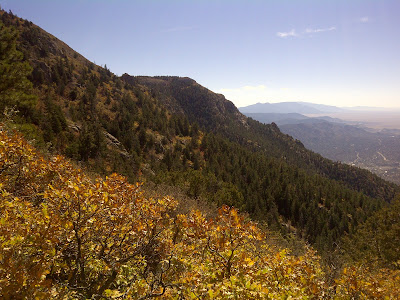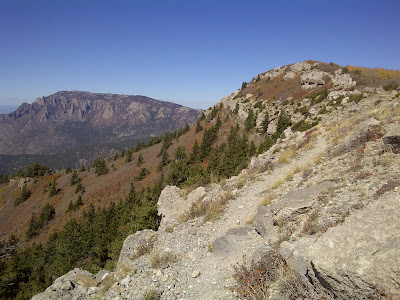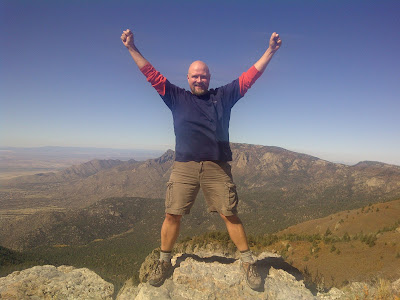 |
| Murray Hill rising above the Cathedral City Starbucks along Highway 111 |
The hike from the Goat Trails to the top of Murray Hill in the lower Santa Rosas is a magical one. I like to start with a cup of joe from the Starbucks in Cathedral City so I can stare up at the summit and imagine myself there while I get the jolt of caffeine I'll need to help get me motivated to make the trip. Climbing more than 1,900 feet in about 3.5 miles - with a couple of ups and downs along the way that add probably another 300 feet of vertical hiking - this 7-mile out-and-back hike is fairly strenuous but still do-able in about four hours for the average hiker.
 |
| This less-than-welcoming sign marks the start of your hike to Murray Hill |
The trailhead just south of the Vons Supermarket at Highway 111 and South Broadmoor Drive in Palm Springs provides ample parking. Start this hike early, as there is no tree-cover, and bring plenty of water. I recommend at least four liters. From the trailhead you will pass through a gate that says no trespassing. I assume this is meant for cars because this is a very popular trail that is listed in many guidebooks. In fact, this trailhead is especially popular because it is where all the mountain bikers access the so-called Goat Trails - a complex network of abandoned dirt roads and single-track trails that you will have to navigate on your way to the entrance to the Clara Burgess Trail, which lead to Murray Hill's summit.
 |
| View of Murray Hill from the Goat Trails, just above the twin water towers |
Beyond the trailhead gate, walk up the road toward twin water towers. Near the top of the hill you will see a driveway leading into the towers on your right. Just past this, you will see a single-track trail that rises sharply up a hill. Take this and continue on it until you reach a wider trail, which is actually an abandoned dirt road. Cross this road and go straight onto another road. Continue until you reach an intersection at the bottom of the hill. Here, you will see another single-track trail that you will follow into Eagle Canyon.
 |
| Dropping into Eagle Canyon is one of my favorite parts of this hike |
Continue on the Eagle Canyon trail as it takes you along the north rim of the canyon. On this trail, at about one mile, you will find a spur that leads down into Jane's Hoffbrau Oasis, a palm oasis that is a perfect destination for a shorter hike and a picnic. To reach Murray Hill, continue on. Shortly, the trail will turn sharply to the right and continue up a couple of switchbacks to the top of a hill where you will pass some serendipitous trail art before descending again into the canyon.
 |
| Take Clara Burgess Trail to Murry Hill summit |
You can take that route, or instead, bypass the extra switchbacks by taking the rugged trail that continues straight along the canyon's rim until it dips down to the canyon floor. Watch your footing here as this is an un-maintained part of the trail. From here, go right and follow the floor of the canyon, scramble up two small dry waterfalls, and just after the second one look closely for a trail that leads up the south wall of the canyon. Take this route up and along the spine of a ridge until you reach a sign for the Clara Burgess Trail. This is where you will begin your ascent of Murray Hill.
 |
| Enjoy lunch with 360° views at the picnic area atop Murray Hill's summit |
Trailhead: Dirt parking lot south of the Vons Supermarket at Highway 111 and South Broadmoor Drive in Palm Springs
Distance: 7 miles out-and-back
Elevation Gain/Loss: 2,200/2,200 feet
Map: The Santa Rosa and San Jacinto Mountains National Monument sells a map that includes this hike for $10. Pick one up at the visitor's center, located at 51500 State Highway 74 in Palm Desert. Also, you can put your Google skills to work to find a GPS map of the Murray Hill hike online.
Hiking Time: About 4 hours, depending on how much time you spend enjoying the sweeping views of the Coachella Valley and surrounding mountains.
Best Times to Hike: The BLM asks that you voluntarily refrain from hiking this trail to protect Bighorn Sheep breeding habitats from January 1 to June 31, although winter is probably the best time to to hike it. This means, your best bet is to hike it from late October through the end of December.
Difficulty: Moderate to Difficult
 |
| This palm oasis in Eagle Canyon means a mile or so to go to the trailhead! |



























